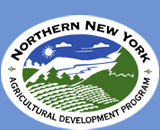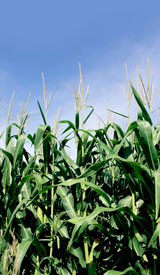June 18, 2007
Contact: Quirine M.
Ketterings, Cornell University, 607-255-3061; local Cornell Cooperative
Extension offices
Too Much Manure? Spreading on Alfalfa Do�s and Don�ts Now Online
Too much manure? A new link on the he Northern New York Agricultural
Development Program website at
www.nnyagdev.org provides information on applying manure to an
established alfalfa crop online. The practice of properly fertilizing
alfalfa is becoming increasingly useful to dairy farmers as government
restrictions require judicious management of manure as an on-farm
nutrient source.
�Nutrient management plans in many dairy regions of the U.S., including
New York State, require that manure application to corn and forage
grasses be limited to only the amount of nitrogen needed by the crop.
This restriction increases the likelihood that manure will need to be
applied to alfalfa fields to take up excess manure,� says Dr. Quirine M.
Ketterings, an associate professor of Crop and Soil Sciences at Cornell
University.
Kettering adds that newly harvested alfalfa fields may at some times,
for example, during the summer cropping season, be the only fields
accessible for dairy spread operations.
Ketterings, Karl Czymmek, a Senior Extension association with Cornell�s
PRO-DAIRY program, and an interdisciplinary team of Cornell colleagues
including NYS Forage Specialist Dr. Jerry Cherney, Animal Science
Professor Dr. Larry Chase, and Quality Milk Production Services Director
and Population Medicine and Diagnostic Sciences Professor Ynte Schukken,
conducted a review of scientific literature on the benefits and
disadvantages of manure application to established alfalfa.
Some of the findings of that literature review include:
� Established mixed alfalfa-grass stands with more than 60 percent do
respond to extra N because of the grass in the stand. These stands are
better alternatives for manure application than newly established clear
seedings of alfalfa.
� Fertilization of a mixed alfalfa-grass stand tends to favor the grass
over the alfalfa resulting in greater N needs with age of the stand.
� Nitrogen addition suppresses but does not eliminate N fixation. Manure
application rates should not exceed the equivalent of 75-85% of N
removed in harvest to minimize annual manure N losses.
� Surface application of manure leads to N losses through
volatilization. In addition, deep cracks in the soil, root channels, and
earthworm burrows can promote preferential flow of manure to tile
drains, so tile outflow should be watched.
� Alfalfa is sensitive to traffic damage. Such damage can be minimized
by planting traffic tolerant varieties, using small tractors for
cutting, raking and harvest, avoiding unnecessary trips across the
field, using larger harvesting equipment, avoiding tractors with dual
wheels, and driving on fields as soon after cutting as possible.
� Delaying manure application after harvest increases burn risk and salt
injury as new leaves are most sensitive to ammonium and salts in the
manure. To reduce the risk of burn, smothering and/or salt injury,
liquid manure application rates should not exceed 4,000 gallons/acre per
application.
� Soil test P levels should be monitored over time as manure application
rates in excess of 4,000 gallons/acre per year will likely result in a P
application that exceeds P crop removal.
� Manured fields should be checked for forage K content if the forage is
being fed to non-lactating cows. It is recommended to only feed forage
with less than 2.5% K (DM basis) to non-lactating cows.
� Application of manure from animals infected with pathogens,
particularly Johne�s disease is a potential method of spreading these
infections. In the case of Johne�s disease, young animals (<1 year)
should not have access to contaminated pastures or to feed from such
fields.
� Although from a water quality point of view, summer application of
manure has great advantages, odor control measures should be implemented
when manure is being applied to sods in the summer months.
A link to the Cornell fact sheet on the Application of Manure to
Established Alfalfa is on the Northern New York Agricultural Development
Program website at www.nnyagdev.org
in the Project Fact Sheets section. # # #



